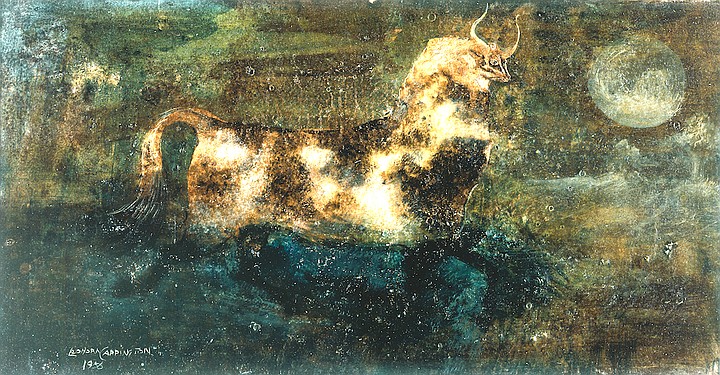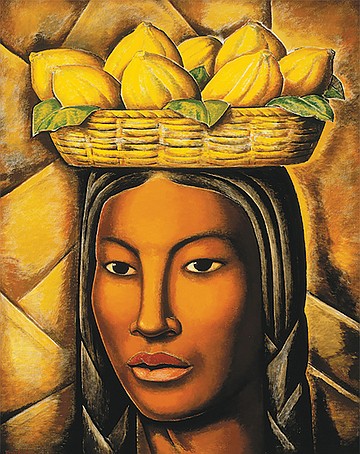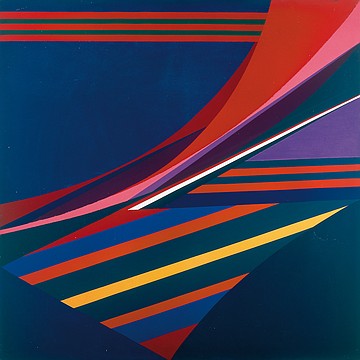 Facebook
Facebook
 X
X
 Instagram
Instagram
 TikTok
TikTok
 Youtube
Youtube

One pleasure of anthology exhibitions is discovering pictures by unfamiliar artists. The English-born artist Leonora Carrington was new to me when I saw a small picture by her in Modern Masters from Latin America, currently at the San Diego Museum of Art, which showcases 99 pictures from the collection of Mexican billionaire Pérez Simón. (From El Greco to Dali, a broader historical selection from his holdings, was in Balboa Park in 2011.) Carrington trained in England, later met and lived with the Surrealist Max Ernst, spent three years in a mental institution, and finally married a Mexican diplomat and moved with him to Mexico.

Her pastoral picture Pied Cow of Heath at first look comes straight out of the tradition of English rural landscape painting going back to John Constable in the early 19th Century. The animal’s patchy coloring, its pied-ness, is so darkly lit that it takes a long look to piece out the image’s strangeness. This is a cow with a difference. Carrington (1917–2011) was an avowed Surrealist, and Surrealism’s foundation was “the uncanny,” the familiar turned strange. Her cow resembles less an actual cow than it does the totemic creatures painted on the walls of Chauvet and Lascaux. Out of a bovine body rises a thick horse’s neck, and the head, which looks like a shrunken adornment glued to the body, is a narrow, horned, ungulate head. In its moonlit, mud-toned landscape, it’s a fabulous creature transforming.

Another pleasure is being surprised by a familiar artist. David Alfaro Siqueiros is usually wadded together with José Clemente Orozco and Diego Rivera, the nationalist muralists who emerged in the 1920s after the Mexican revolution. Like them, he spent time in the United States. Teaching in his later career in New York, Siqueiros taught students Navajo sand-painting, which is poured hand-to-floor; Jackson Pollock was among his students. His work’s rude energy and immediacy are emotionally overwhelming and sometimes tip into mannered excess. But Death in Life (or Black Christ), a muscular depiction of enslavement and frustrated fury, is among his greatest pictures. A black male kneels in a field of crusty flowers, fists clenched, head bowed; he’s self-sacrificial and defiant — bloody red rivulets outline parts of his body.

The muralists are all represented here, and the subtext to their inclusion is that they were critical in bringing to Mexican art changes being worked in Western Europe by Cubism, Surrealism, and Expressionism. One has to be careful not to reverse engineer what one sees in a show like this. It’s wrong-headed to read the pictures as a checklist of European influences enlivened by indigenous subject matter. At the same time, a little reverse engineering is inevitable when the influence lies heavily, as it does in the hard-edged Minimalist imagery of the Argentine-born Japanese Kazuya Sakai, whose swooping ribbons and sharp triangulations of solid colors in his 1971 Genroku, speak to the kind of hard-edge abstraction being practiced in North America and Europe. And the Chilean Roberto Matta, in his 1971 Tornado of Sensations, pays unmistakable homage to his friend Arshile Gorky’s biomorphic language of fangs, talons, ribs, and bones rendered in tissued color.

Most of these painters were claiming local, native materials and mediating their expression with modernist means. A few paintings are heavy with local-color preciosity, but an artist like Benito Quinquela Martín takes a modest local subject, a boat graveyard (Cementario de barcos, from 1930), but exerts such pictorial pressures with heavy slabs and bars of pigment laid on with brush and palette knife that he pulls his motif out of the taming sentiments of the picturesque. A different drama occurs when an artist like the Uruguayan Pedro Blanes Viale transforms a familiar motif of women standing under orange trees into a storm of congested tropical color: he draws energy from the Fauve bravura of Derain and Matisse to dramatize how the human gets caught up and nearly obliterated in nature’s cyclical energies.
The dominant image of womanhood in Modern Masters from Latin America is the iconic campesina, who in Alfredo Ramos Martínez’s monumental celebration of solemn Indian beauty, La india, appears as a sculptural, mineralized peasant woman carrying a basket of mangos on her head. There are other female types, like the Rita Hayworth glamour of Rivera’s portrait of the Mexican actress Maria Félix, whose high-arching eyebrows point toward her wildly wavy indigo mane. A more socially ambiguous representation is the Nicaraguan Armando Morales’s painting of two nude women bathing in an irrigation ditch; the women look mythic in their modesty and ordinariness, risen from the dim canal waters. The bluish-gold marbling that defines the concrete ditch also wraps around the women’s heads like shining verdigris helmets.


One pleasure of anthology exhibitions is discovering pictures by unfamiliar artists. The English-born artist Leonora Carrington was new to me when I saw a small picture by her in Modern Masters from Latin America, currently at the San Diego Museum of Art, which showcases 99 pictures from the collection of Mexican billionaire Pérez Simón. (From El Greco to Dali, a broader historical selection from his holdings, was in Balboa Park in 2011.) Carrington trained in England, later met and lived with the Surrealist Max Ernst, spent three years in a mental institution, and finally married a Mexican diplomat and moved with him to Mexico.

Her pastoral picture Pied Cow of Heath at first look comes straight out of the tradition of English rural landscape painting going back to John Constable in the early 19th Century. The animal’s patchy coloring, its pied-ness, is so darkly lit that it takes a long look to piece out the image’s strangeness. This is a cow with a difference. Carrington (1917–2011) was an avowed Surrealist, and Surrealism’s foundation was “the uncanny,” the familiar turned strange. Her cow resembles less an actual cow than it does the totemic creatures painted on the walls of Chauvet and Lascaux. Out of a bovine body rises a thick horse’s neck, and the head, which looks like a shrunken adornment glued to the body, is a narrow, horned, ungulate head. In its moonlit, mud-toned landscape, it’s a fabulous creature transforming.

Another pleasure is being surprised by a familiar artist. David Alfaro Siqueiros is usually wadded together with José Clemente Orozco and Diego Rivera, the nationalist muralists who emerged in the 1920s after the Mexican revolution. Like them, he spent time in the United States. Teaching in his later career in New York, Siqueiros taught students Navajo sand-painting, which is poured hand-to-floor; Jackson Pollock was among his students. His work’s rude energy and immediacy are emotionally overwhelming and sometimes tip into mannered excess. But Death in Life (or Black Christ), a muscular depiction of enslavement and frustrated fury, is among his greatest pictures. A black male kneels in a field of crusty flowers, fists clenched, head bowed; he’s self-sacrificial and defiant — bloody red rivulets outline parts of his body.

The muralists are all represented here, and the subtext to their inclusion is that they were critical in bringing to Mexican art changes being worked in Western Europe by Cubism, Surrealism, and Expressionism. One has to be careful not to reverse engineer what one sees in a show like this. It’s wrong-headed to read the pictures as a checklist of European influences enlivened by indigenous subject matter. At the same time, a little reverse engineering is inevitable when the influence lies heavily, as it does in the hard-edged Minimalist imagery of the Argentine-born Japanese Kazuya Sakai, whose swooping ribbons and sharp triangulations of solid colors in his 1971 Genroku, speak to the kind of hard-edge abstraction being practiced in North America and Europe. And the Chilean Roberto Matta, in his 1971 Tornado of Sensations, pays unmistakable homage to his friend Arshile Gorky’s biomorphic language of fangs, talons, ribs, and bones rendered in tissued color.

Most of these painters were claiming local, native materials and mediating their expression with modernist means. A few paintings are heavy with local-color preciosity, but an artist like Benito Quinquela Martín takes a modest local subject, a boat graveyard (Cementario de barcos, from 1930), but exerts such pictorial pressures with heavy slabs and bars of pigment laid on with brush and palette knife that he pulls his motif out of the taming sentiments of the picturesque. A different drama occurs when an artist like the Uruguayan Pedro Blanes Viale transforms a familiar motif of women standing under orange trees into a storm of congested tropical color: he draws energy from the Fauve bravura of Derain and Matisse to dramatize how the human gets caught up and nearly obliterated in nature’s cyclical energies.
The dominant image of womanhood in Modern Masters from Latin America is the iconic campesina, who in Alfredo Ramos Martínez’s monumental celebration of solemn Indian beauty, La india, appears as a sculptural, mineralized peasant woman carrying a basket of mangos on her head. There are other female types, like the Rita Hayworth glamour of Rivera’s portrait of the Mexican actress Maria Félix, whose high-arching eyebrows point toward her wildly wavy indigo mane. A more socially ambiguous representation is the Nicaraguan Armando Morales’s painting of two nude women bathing in an irrigation ditch; the women look mythic in their modesty and ordinariness, risen from the dim canal waters. The bluish-gold marbling that defines the concrete ditch also wraps around the women’s heads like shining verdigris helmets.
Comments